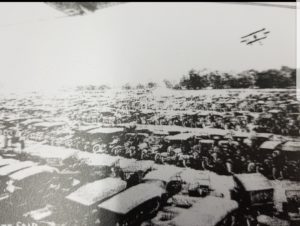
Monster trucks, country concerts, and horse races: Over the 167 years of its history, the Hillsdale County Fair has seen all sorts of attractions.
Old newspaper clips even report that Wilbur and Orville Wright, the brothers who became the first to fly an airplane in 1903, performed a demonstration at the Hillsdale County Fair more than a century ago, according to Cinda Walton, the fair’s historian. That, however, may only be a legend, Wright-brothers experts told The Collegian.
“It’s not true,” said Stephen Wright, the great-grandnephew of the brothers. “They never flew there in Hillsdale County.”
Edward Roach, the historian at the Dayton Aviation Heritage National Historical Park in Dayton, Ohio, agreed: “There’s lots of these rumors or legends that get out. Everyone wants to lay claim to them.”
Newspaper articles offer several different accounts of the alleged show, Walton said. Some say both brothers, others just one of the two, took off from, flew around, and landed in the inner oval of the track on the fairgrounds in an early version of their flying machine. Reports included four possible years for the visit: 1904, 1905, 1910, and 1915.
Most commonly cited are 1904 and 1905, but Roach said the brothers were not in the business of doing such demonstrations at the time, less than a year or two after their four successful flights at Kitty Hawk, North Carolina. The brothers were still tinkering with their invention at that point, flying only at Huffman Prairie near Dayton, said Tom Crouch, the senior curator of aeronautics at the Smithsonian Institution’s National Air and Space Museum in Washington, D.C. The technology was not yet ready for aerial performances.
“And they were being very secretive about their work — they wanted to patent what they’d done, and they didn’t want others stealing their idea before it was patented,” Roach said.
Other accounts of the Hillsdale performance even allege the original plane that took off in North Carolina was the one flown at the county fair. That flying machine, however, crashed after its fourth successful flight at Kitty Hawk and did not fly again.
Although 1910 is the most likely year that a Wright-brothers plane would have flown in Hillsdale, there is no record of the visit in the Wright Co.’s accounting ledger, according to Roach.
During 1910 and 1911, the Wright Co. did have an exhibition team that traveled across the world, including to fairs, to show the miracle of flight and dabble in tricks such as circles and corkscrews — in planes without seatbelts or oxygen masks.
“If you start going up to a certain height, the amount of oxygen decreases, and you would black out,” Roach said. “Without a seatbelt, your life span is not going to be too long, and many lost control and did crash. It was a very dangerous occupation to be in at that time.”
Several pilots did die, and the brothers shut down the exhibitions for safety reasons about a year after they began.
“Glenn Curtiss’ company was doing exhibitions, too,” Stephen Wright said. “The pilots were becoming more and more like daredevils, so Wilbur and Orville turned it off. It was all about safety for them.”
Although the ledger does not mention a performance in Hillsdale, the exhibition team flew a total of six times in Michigan in Battle Creek, Detroit, Grand Rapids, and Saginaw.
By 1915, the aviation world had taken off, and the Wrights were no longer leaders in their field. Wilbur Wright died in 1912 at the age of 45 from typhoid fever. Orville Wright, meanwhile, was busy in court protecting their patents from competitor Glenn Curtiss. He, however, had sustained an injury to a nerve in the back of his leg after an accident in 1908 during a demonstration for the U.S. Army. As a result, Orville Wright did not do much more flying after that, and his final takeoff was in 1918, Roach said.
The Mitchell Research Center has two photos with captions referencing the brothers’ supposed visit. Crouch said one of the photos shows a plane with ailerons, which helped control the plane. The Wright brothers’ planes did not have ailerons, but Curtiss’ did.
According to the Glenn H. Curtiss Museum in Hammondsport, New York, there is no record of the company performing a demonstration in Hillsdale County. However, Art Smith of Fort Wayne, Indiana, built his own plane based on the Curtiss design and reportedly flew over the city of Hillsdale at least twice. He gained national attention when he and his girlfriend had an aerial elopement and the couple crashed into a field near Oak Grove Cemetery. They were sent to a local hotel for treatment and married.
The other photo from the research center does depict a Wright plane, likely a Model A built from 1907-1909, Crouch said. Its caption, however, makes it unclear if the photo is from the alleged visit to Hillsdale and dates the exhibition to 1904 or 1905.
“I guarantee that they didn’t fly anywhere but Kitty Hawk or Huffman Prairie before the summer of 1908,” Crouch said.

